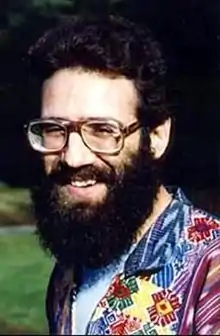Steven Hayden Pollock
Steven Hayden Pollock was a mycologist who studied psychoactive mushrooms and published many articles on the potential of mushrooms to treat illness and improve quality of life.[4][5]:81[6]:55
M.D. Steven Hayden Pollock | |
|---|---|
 | |
| Born | August 12, 1947[1][2] |
| Died | February 1, 1981 (aged 33)[1][3] |
| Cause of death | Murder |
| Resting place | Mission Burial Park North, San Antonio, Texas 29.635249°N 98.610142°W [1] |
| Nationality | American |
| Education | graduated from the Medical College of Wisconsin in 1975, and did research at University of Texas Department of Pharmacology[3]:6 |
| Partner(s) | Mitzi Moore[3]:7 |
| Parent(s) |
|
| Scientific career | |
| Fields | Mycology |
| Institutions | Herbal Medicine Research Foundation, San Antonio, TX, and a Winnebago laboratory[3]:10 |
| Academic advisors | |
Life and career
Pollock and Gary Lincoff found an entirely new species, and named it Psilocybe tampanensis, in Tampa, FL, September 3, 1977 while the Second International Mycological Congress was happening, Pollock was so excited he said they discovered the philosopher’s stone.[7][3]:3–4
He wrote the Magic Mushroom Cultivation book in 1977, it contained his research on several ways to cultivate magic mushrooms,[8] including the cultivation in brown rice that was later demonstrated to produce mushrooms of high psilocybin content.[3]:6
Pollock isolated a strain of P. tampanensis that produced sclerotia of a size much bigger than known before. This discovery enabled a means of using psilocybin in places where magic mushrooms are illegal, such as after the magic mushroom ban in Amsterdam on December 1, 2008.[9][10][3]:6,16
Pollock envisioned creating the first legal medical mushroom research laboratory and estimated he would need about 2 million dollars to set it up.[3]:6–8 Together with another mushroom lover, Michael Forbes, they founded a company called Hidden Creek in 1979 to sell P. tampanensis sclerotium by mail; they advertised in the monthly magazine High Times,[11] and became the largest magic mushroom vendor in the world within the same year.[3]:6
He sold mushrooms, prescriptions, and planted an acre of cannabis to get the funds he needed to his research. He traveled to the Amazon and Mexico to study psychoactive mushrooms and discovered 3 species in 1979: Psilocybe armandii, Psilocybe wassoniorum, and Psilocybe schultesii.[3]:7–8 In 1980, because of his high volume of illegal prescription writing, the state pharmacy board alerted employees about his practice. As a work-around Pollock bought his own pharmacy to supply his customers.[3]:8
Death
Pollock worked 7 days a week; on a Saturday at 7 PM he arranged with his girlfriend Mitzi by phone to meet for dinner, but he had a last patient scheduled to come that night. Mitzi called him several times through the night, but he did not answer. Worried, she ran to his office at 11 PM and found the house ransacked. Pollock was in the corner beside the front door, shot dead in the forehead.
The police found 1,753 jars of growing psychoactive mushrooms in his greenhouse that were dumped and burned by San Antonio Narcotics Force.[3]:10–12 Gary Davis, Pollock's friend, got a tape of two people talking about Pollock's murder, but kept it in the fear someone would kill him.[3]:13
In 1983, detective Anton Michalec found three suspects, Ernest Dietzmann and Jerry Baker that were drug dependents and patients of Pollock's, and Arthur Lenz, a methamphetamine dealer. They intended to rob Pollock of his money, and their fingerprints matched those found at the crime scene. Michalec brought the case to the district attorney Terry McDonald, who refused to prosecute for unknown reasons, and Michalec's work was forgotten. All three suspects died free men.
In 2013, when journalist Hamilton Morris contacted McDonald, who explained he actually wasn't the district attorney at that time, Morris tried to investigate and was informed by the DEA that they had destroyed and/or lost the records and information about who was responsible for the case.[3]:14
See also
References
- "Grave Site of Dr. Steven Hayden Pollock (1947-1981)". BillionGraves. Retrieved 2 June 2017.
- "Steven Hayden Pollock - Birth Event". Family Search. Retrieved 2 June 2017.
- Hamilton Morris (July 2013). "Blood Spore: Of Murder and mushrooms". Harper's Magazine. Retrieved 2 June 2017.
- Pollock, Steven Hayden (October 1976). "Liberty Caps: recreational hallucinogenic mushrooms". Drug and Alcohol Dependence. Elsevier Science. 1 (6): 445–447. doi:10.1016/0376-8716(76)90010-7. ISSN 0376-8716. PMID 1035156.
- Pollock, Steven Hayden (17 January 2012). "The Psilocybin Mushroom Pandemic". Journal of Psychedelic Drugs. Taylor & Francis. 7 (1): 73–84. doi:10.1080/02791072.1975.10472640. ISSN 0022-393X.
- Pollock, Steven Hayden (17 January 2012). "Psilocybian Mycetismus With Special Reference To Panaeolus". Journal of Psychedelic Drugs. Taylor & Francis. 8 (1): 43–57. doi:10.1080/02791072.1976.10472007. ISSN 0022-393X.
- Steven Hayden Pollock; Gastón Guzmán (July–September 1978). "A new bluing species of Psilocybe from Florida, U.S.A." (PDF). Mycotaxon. 7 (2): 373–376. ISSN 0093-4666. Retrieved 2 June 2017.
- H. Pollock, Steven (1977). Magic Mushroom Cultivation. San Antonio: Herbal Medicine Research Foundation. ISBN 9780930074012.
- "Truffle takes over from the magic mushroom". DutchNews.nl. 1 December 2011. Retrieved 3 June 2017.
- "Amsterdam tourists mad about truffle trips". RNW Media. Retrieved 3 June 2017.
- "Hidden Creek - Magic Mushroom Farms". High Times. No. 44. April 1979. p. 108. ISSN 0362-630X.